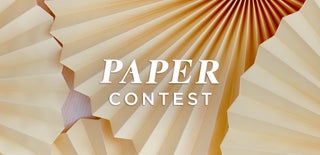Introduction: Paper Molecular Models
Ideal for the class-room, but also impossible to resist for the science geek: make your own molecular models with just paper, glue and paint!
The 3-dimensional molecular geometry determines many of the chemical and physical properties of the matter that surround us, and nothing beats holding a physical model in your hands to fully grasp its shape in three dimensions.
Plastic molecular modelling sets exist, but they tend to be expensive, small and not very suitable for permanent display. With paper we can make larger models cheaply. They are glued together, so once assembled the atoms cannot be reused to make new combinations, but on the other hand, these fixed models are very suitable for permanent display.
This instructable contains pdf files for 4 shapes that can be printed on regular paper. They represent hydrogen (white), carbon (black), nitrogen (blue) and oxygen (red), from which a huge number of organic molecules can be built up. By using different colours from the CPK colour scheme also other atoms can be represented, such as sulphur (yellow), chlorine and fluorine (green) and phosphor (orange)
- hydrogen.pdf has 2 outlines for the small hydrogen atom.
- linear.pdf has the shape for a linear geometry , for carbon with a triple bond or two double bonds, and for nitrogen with a double bond.
- trigonal.pdf has the shape for the trigonal planar geometry, for carbon with one double bond or in aromatic rings like benzene. It actually has 5 faces, so it's also good for the trigonal trigonal bipyramidal geometry! https://en.wikipedia.org/wiki/Trigonal_bipyramidal_molecular_geometry
- tetrehedral.pdf has the shape for the tetrahedral geometry. It represents a carbon atom but also nitrogen in the trigonal pyramidal geometry and oxygen in the bent geometry. Moreover, it is suitable for any large atom that binds with only one other atom.
All shapes have one or more faces that is a regular hexagonal with sides of 3cm length. The atoms are combined into molecules by gluing these faces together.
The python script used to make these shapes is attached in the final step, so you can edit the size, shape and line thickness at will.
Step 1: Materials and Tools
Materials:
- Paper - regular A4 printer/copier paper 80g/m^2
- Paint - red, blue, black and white acrylic
- Glue - PVA (the white milky type: Vinavil, Elmers)
Tools:
- A printer: ink jet or laser
- Scissors or sharp hobby knife
- A large paintbrush for painting
- A small paint brush for glueing
Step 2: Print the Shapes
Choose the molecule that you want to make and print out the pages in the quantities required.
for example:
- oxygen, O2: 2 tetrahedral
- water, H2O: 2 hydrogen, 1 tetrahedral
- carbon dioxide, CO2: 1 linear, 2 tetrahedral
- ammonia, NH3: 3 hydrogen, 1 tetrahedral
- methane, CH4: 4 hydrogen, 1 tetrahedral
- formamide, COHNH2: 2 tetrahedral, 1 trigonal, 3 hydrogen
- ethanol, CH3-CH2OH: 3 tetrahedral, 6 hydrogen
- acetone, CH3-CO-CH3: 4 tetrahedral 6 hydrogen
- benzene, C6H6: 6 trigonal, 6 hydrogen
- glucose, C6H12O6: 12 tetrahedral 12 hydrogen
Regular white 80g/m^2 paper is fine, thicker paper (100 or 120g/m^2) might give extra strength. If you can’t print on thick paper directly, you can print on regular paper and then make photocopies on thicker paper. Printing directly on coloured paper could be a good way to get evenly coloured models and skip the painting step.
Step 3: Paint the Sheets
Painting paper makes it wet, soft and deformed, but it regains its original shape and strength when dry. Therefore, it is best to paint the sheet before cutting folding and glueing.
Paint the paper on the back side, so we can use the printed lines for folding, but they’ll be on the inside and thus invisible. It is not needed to paint the whole sheet, it is sufficient to cover the part that will be cut out.
Even though the acrylic paint is dry to touch within 10 minutes, the paper will remain humid, soft and bobbly for a while. Letting it dry overnight will help to regain its shape and strength. Painting in two layers, first thin, then thick, gives best results.
Step 4: Cut and Fold the Shapes
The shapes can be cut out with regular scissors or with a sharp knife. All the lips and edges need to be folded sharply and precisely. First fold from the printed side, then fold back from the painted side.
Step 5: Glue the Shapes
All shapes consist of a top, a bottom, and six sides. Glue the shapes one side at a time. The side that contains the top and no lips should be glued last.
The glue of choice is the common PVA (Polyvinyl acetate) type: thick and milky, with paper it dries in a few minutes. It is water based, so no toxic solvents are released.
Apply the glue with a paintbrush on all the lips of one side and press the next side to it. Repeat for all sides and finish off with the top. Done!
Step 6: Put the Model Together
The individual atoms can now be glued together to form complete models of molecules. Atoms should be connected only through the sides that are regular hexagons. The molecule in the picture is formamide, COH-NH2.
They are now ready for display. Since they are so light, they can be hung from the ceiling on sewing thread, and show their full 3D structure by moving with the air flow.
Step 7: Appendix: the Code
Attached here is the python script used to make the shapes. It requires the ROOT libraries for graphics. All shapes are defined as regular or alternating tubes, and the algorithm to draw those is generic. Variations of the shapes can be made by varying the parameters in the calls to regtube() and alttube()
Attachments

Participated in the
Paper Contest















